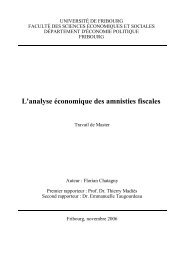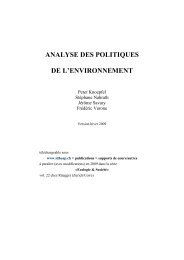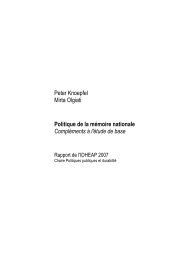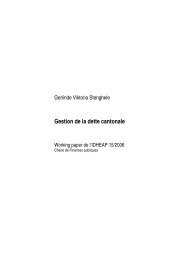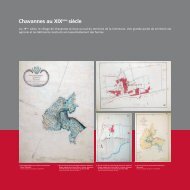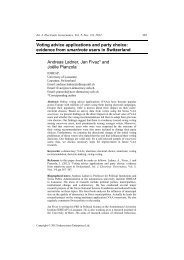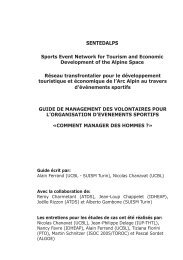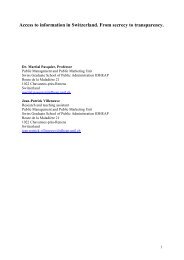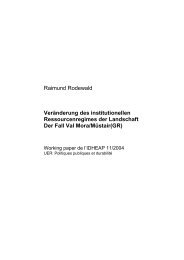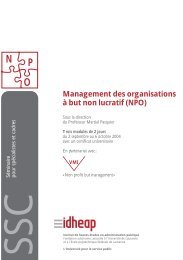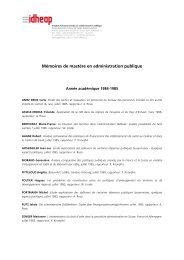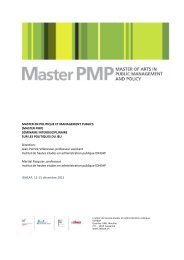Historical Analysis of Institutional Regimes in Switzerland ... - IDHEAP
Historical Analysis of Institutional Regimes in Switzerland ... - IDHEAP
Historical Analysis of Institutional Regimes in Switzerland ... - IDHEAP
Create successful ePaper yourself
Turn your PDF publications into a flip-book with our unique Google optimized e-Paper software.
9<br />
From an empirical po<strong>in</strong>t <strong>of</strong> view, the analysis <strong>of</strong> the transformation and effects <strong>of</strong> an IR would<br />
imply the identification <strong>of</strong> the above-mentioned constitutional elements <strong>of</strong> the IR. The diachronic<br />
analysis will make it possible to make a statement on the breadth <strong>of</strong> the IR and will reveal the<br />
goods and services for which the use <strong>of</strong> the resource was regulated us<strong>in</strong>g specific public policies,<br />
or by means <strong>of</strong> the <strong>in</strong>troduction <strong>of</strong> property and use rights over time. The coherence <strong>of</strong> the IR<br />
can be evaluated by comb<strong>in</strong><strong>in</strong>g the policy design and property and use rights.<br />
In the empirical analysis, a dist<strong>in</strong>ction should be drawn between the formal legal nature <strong>of</strong> state<br />
<strong>in</strong>terventions and title to property and the actual <strong>in</strong>centives set for <strong>in</strong>dividual behaviour <strong>in</strong> relation<br />
to the goods and services provided by the resource. Hence, it is completely possible for the use<br />
rights to be rendered concrete or new property rights recognised through public policies. As a<br />
component <strong>of</strong> public policies, the <strong>in</strong>struments which are relevant to use rights affect the regulative<br />
system. New use rights, such as the access right, may have been <strong>in</strong>troduced, however the formal<br />
change may have been the result <strong>of</strong> the redesign <strong>of</strong> the protection and use policy.<br />
4.2 The typology <strong>of</strong> <strong>Institutional</strong> Resource <strong>Regimes</strong><br />
It is very difficult to classify IRs at present. As a heuristic assumption, we postulate a variable<br />
degree <strong>of</strong> differentiation (on the basis <strong>of</strong> the goods and services provided by the resource) <strong>of</strong> the<br />
property and use rights and <strong>of</strong> the design <strong>of</strong> the relevant public policies for different natural<br />
resources (see Figure 1). Different stages <strong>of</strong> the development <strong>of</strong> an IR development can be<br />
identified from a theoretical po<strong>in</strong>t <strong>of</strong> view:<br />
Figure 1: Gradual differentiation <strong>of</strong> <strong>Institutional</strong> Resource <strong>Regimes</strong><br />
Degree <strong>of</strong><br />
differentiation<br />
<strong>of</strong> the resourcespecific<br />
policy design<br />
complex IR<br />
simple IR<br />
complex IR<br />
<strong>in</strong>tegrated IR<br />
No IR<br />
simple IR<br />
complex IR<br />
Degree <strong>of</strong> differentiation <strong>of</strong> the regulative system<br />
• From a theoretical po<strong>in</strong>t <strong>of</strong> view, we speak <strong>of</strong> a "no IR situation", <strong>in</strong> cases where<br />
neither property and use rights nor public policies exist. Chances are <strong>in</strong> this <strong>in</strong>stance that<br />
a resource or its services and goods have not yet been discovered. This was the case for<br />
biodiversity until recently.<br />
• If the use rights are formulated either directly <strong>in</strong> detailed regulative systems (e.g. new<br />
def<strong>in</strong>ition and application <strong>of</strong> property and use rights) and/or at least <strong>in</strong>directly through an<br />
<strong>in</strong>itial policy design (e.g. general police clause for protection <strong>of</strong> use rights or bans and<br />
licence reservations), this can be referred to as a “simple IR situation”. We suspect<br />
that this k<strong>in</strong>d <strong>of</strong> simple IR emerges when the central actors observe scarcity <strong>in</strong><br />
connection with the predom<strong>in</strong>antly homogenous use <strong>of</strong> one or several goods or services



